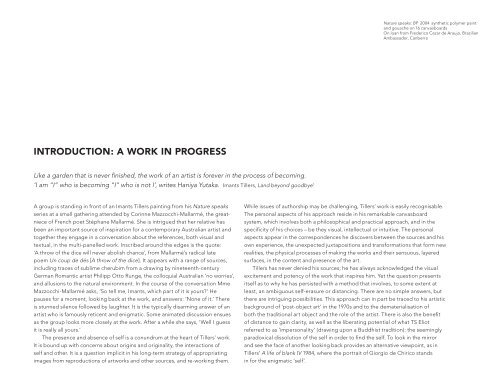introduction: a work in progress - National Gallery of Australia
introduction: a work in progress - National Gallery of Australia
introduction: a work in progress - National Gallery of Australia
Create successful ePaper yourself
Turn your PDF publications into a flip-book with our unique Google optimized e-Paper software.
Nature speaks: BP 2004 synthetic polymer pa<strong>in</strong>t<br />
and gouache on 16 canvasboards<br />
On loan from Frederico Cezar de Araujo, Brazilian<br />
Ambassador, Canberra<br />
INTRODUCTION: A WORK IN PROGRESS<br />
Like a garden that is never f<strong>in</strong>ished, the <strong>work</strong> <strong>of</strong> an artist is forever <strong>in</strong> the process <strong>of</strong> becom<strong>in</strong>g.<br />
‘I am “I” who is becom<strong>in</strong>g “I” who is not I’, writes Haniya Yutaka. Imants Tillers, Land beyond goodbye 1<br />
A group is stand<strong>in</strong>g <strong>in</strong> front <strong>of</strong> an Imants Tillers pa<strong>in</strong>t<strong>in</strong>g from his Nature speaks<br />
series at a small gather<strong>in</strong>g attended by Cor<strong>in</strong>ne Mazzocchi-Mallarmé, the greatniece<br />
<strong>of</strong> French poet Stéphane Mallarmé. She is <strong>in</strong>trigued that her relative has<br />
been an important source <strong>of</strong> <strong>in</strong>spiration for a contemporary <strong>Australia</strong>n artist and<br />
together they engage <strong>in</strong> a conversation about the references, both visual and<br />
textual, <strong>in</strong> the multi-panelled <strong>work</strong>. Inscribed around the edges is the quote:<br />
‘A throw <strong>of</strong> the dice will never abolish chance’, from Mallarmé’s radical late<br />
poem Un coup de dés [A throw <strong>of</strong> the dice]. It appears with a range <strong>of</strong> sources,<br />
<strong>in</strong>clud<strong>in</strong>g traces <strong>of</strong> sublime cherubim from a draw<strong>in</strong>g by n<strong>in</strong>eteenth-century<br />
German Romantic artist Philipp Otto Runge, the colloquial <strong>Australia</strong>n ‘no worries’,<br />
and allusions to the natural environment. In the course <strong>of</strong> the conversation Mme<br />
Mazzocchi-Mallarmé asks, ‘So tell me, Imants, which part <strong>of</strong> it is yours?’ He<br />
pauses for a moment, look<strong>in</strong>g back at the <strong>work</strong>, and answers: ‘None <strong>of</strong> it.’ There<br />
is stunned silence followed by laughter. It is the typically disarm<strong>in</strong>g answer <strong>of</strong> an<br />
artist who is famously reticent and enigmatic. Some animated discussion ensues<br />
as the group looks more closely at the <strong>work</strong>. After a while she says, ‘Well I guess<br />
it is really all yours.’<br />
The presence and absence <strong>of</strong> self is a conundrum at the heart <strong>of</strong> Tillers’ <strong>work</strong>.<br />
It is bound up with concerns about orig<strong>in</strong>s and orig<strong>in</strong>ality, the <strong>in</strong>teractions <strong>of</strong><br />
self and other. It is a question implicit <strong>in</strong> his long-term strategy <strong>of</strong> appropriat<strong>in</strong>g<br />
images from reproductions <strong>of</strong> art<strong>work</strong>s and other sources, and re-<strong>work</strong><strong>in</strong>g them.<br />
While issues <strong>of</strong> authorship may be challeng<strong>in</strong>g, Tillers’ <strong>work</strong> is easily recognisable.<br />
The personal aspects <strong>of</strong> his approach reside <strong>in</strong> his remarkable canvasboard<br />
system, which <strong>in</strong>volves both a philosophical and practical approach, and <strong>in</strong> the<br />
specificity <strong>of</strong> his choices – be they visual, <strong>in</strong>tellectual or <strong>in</strong>tuitive. The personal<br />
aspects appear <strong>in</strong> the correspondences he discovers between the sources and his<br />
own experience, the unexpected juxtapositions and transformations that form new<br />
realities, the physical processes <strong>of</strong> mak<strong>in</strong>g the <strong>work</strong>s and their sensuous, layered<br />
surfaces, <strong>in</strong> the content and presence <strong>of</strong> the art.<br />
Tillers has never denied his sources; he has always acknowledged the visual<br />
excitement and potency <strong>of</strong> the <strong>work</strong> that <strong>in</strong>spires him. Yet the question presents<br />
itself as to why he has persisted with a method that <strong>in</strong>volves, to some extent at<br />
least, an ambiguous self-erasure or distanc<strong>in</strong>g. There are no simple answers, but<br />
there are <strong>in</strong>trigu<strong>in</strong>g possibilities. This approach can <strong>in</strong> part be traced to his artistic<br />
background <strong>of</strong> ‘post-object art’ <strong>in</strong> the 1970s and to the dematerialisation <strong>of</strong><br />
both the traditional art object and the role <strong>of</strong> the artist. There is also the benefit<br />
<strong>of</strong> distance to ga<strong>in</strong> clarity, as well as the liberat<strong>in</strong>g potential <strong>of</strong> what TS Eliot<br />
referred to as ‘impersonality’ (draw<strong>in</strong>g upon a Buddhist tradition): the seem<strong>in</strong>gly<br />
paradoxical dissolution <strong>of</strong> the self <strong>in</strong> order to f<strong>in</strong>d the self. To look <strong>in</strong> the mirror<br />
and see the face <strong>of</strong> another look<strong>in</strong>g back provides an alternative viewpo<strong>in</strong>t, as <strong>in</strong><br />
Tillers’ A life <strong>of</strong> blank IV 1984, where the portrait <strong>of</strong> Giorgio de Chirico stands<br />
<strong>in</strong> for the enigmatic ‘self’.

















